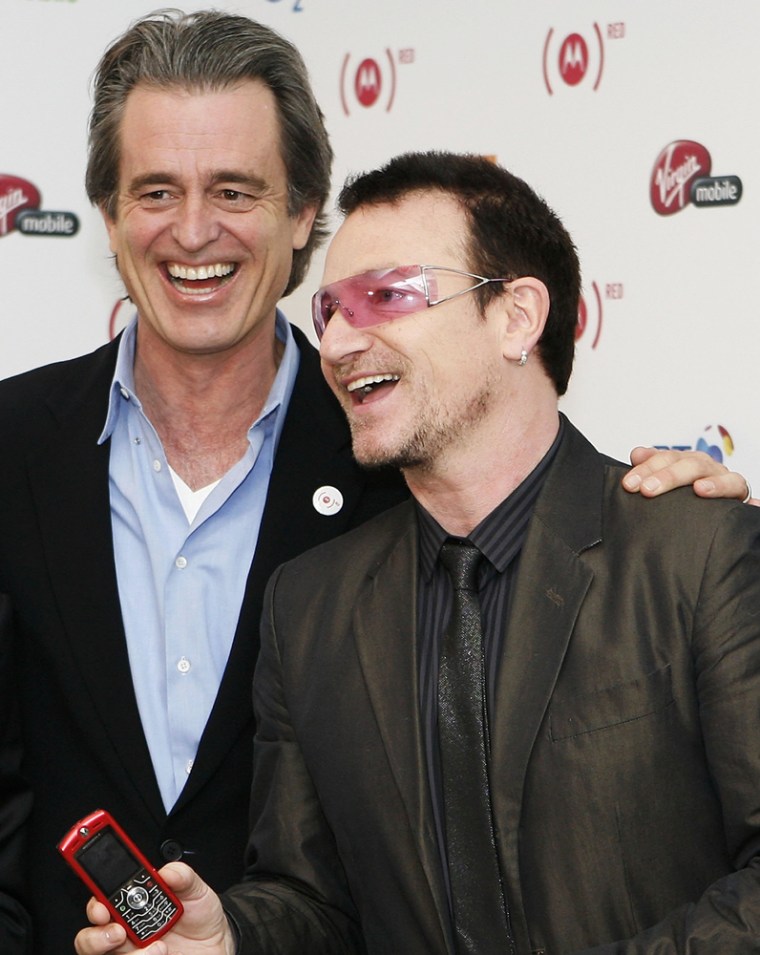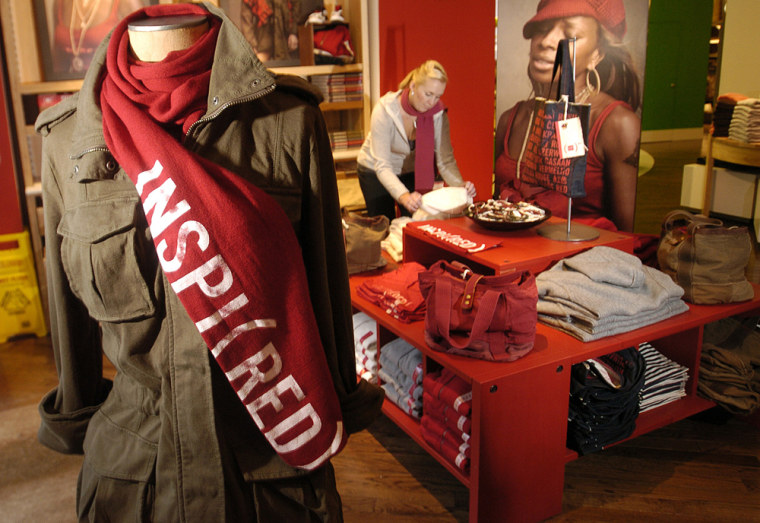At the 2007 Advertising Club's Advertising Person of the Year Award lunch in Manhattan in September, some of the slogans for the Product (RED) brand were fixed prominently at the center of each table. “My Narcissism Has Gone Global,” said one; “Be A Good Looking Samaritan,” said another. Bobby Shriver, one of the two founders of (RED) receiving the club’s top award, was cheered on by his sister, Maria Shriver, and her husband, California Governor Arnold Schwarzenegger. Organizers projected a slideshow: gaunt, skeletal figures replaced by photos of the same people after (RED)-sponsored HIV treatment — healthy, smiling, double their weight, and earning their own money.
Product (RED), an AIDS fundraising effort co-founded by U2 singer Bono and Santa Monica, Calif., Councilman Shriver, has taken Madison Avenue consumerism to African AIDS clinics. With the help of corporate partners American Express, Apple, Armani, Converse, GAP, Hallmark, and Motorola, the campaign has raised tens of millions of dollars for the Global Fund to Fight AIDS, Tuberculosis, and Malaria, a joint government/corporate initiative established in 2002 at the urging of then-UN Secretary General Kofi Annan to increase resources to fight three of the world’s most devastating diseases.
The idea behind (RED) is simple: persuade youth-oriented brands to produce a Product (RED) line, charge them a licensing fee, share the proceeds, and then (RED)’s share of the profits go directly to The Global Fund — no heavy overheads, no nonprofit bureaucracy. With celebrities dripping from the cause, it attracted major corporate interest. But 18 months into its existence, (RED) is still struggling to define itself — and has yet to tell consumers precisely how much of their donor money is getting to the needy.
The founders of (RED) are unabashedly unapologetic about it, and don’t seem to know, nor care all that much, whether their corporate partners are benefiting more than the HIV-positive mothers (RED) is trying to assist in Africa. What matters, they say, is not a strict accounting of that balance but rather that (RED) is able to siphon off some consumer and corporate dollars for a desperately necessary cause. “When you see people dying and you realize the money could go at any moment, I don’t really think too much about whether a company is taking advantage of me,” Shriver told CONTRIBUTE in an interview. “You’re giving me 50 percent of your profits? Nice to meet you. Congratulations. Have a nice day. And you’re going to run all that advertising that says there’s an issue called AIDS in Africa? God bless you.”
'Definitely not a charity'
But is (RED) simply a short-lived marketing gimmick that backlights celebrity careers or is it an innovative approach to fundraising in which the deepest desires of capitalism and philanthropy finally find each other? The Wall Street Journal was forced to issue a correction earlier this year when it called Product (RED) a “nonprofit.” (RED), itself, says it’s somewhere between a “nonprofit” and a “forprofit nonprofit” — but it’s “definitely not a charity,” says President Tamsin Smith.

Certainly, a brand that raises money for a good cause by combining the mutually beneficial support of philanthropy and the marketplace sounds like boilerplate cause marketing — the type used so effectively by the breast cancer pink ribbon campaign to raise millions of dollars each year. “(RED) is really no different than the Pink campaign for breast cancer with its product and celebrity endorsements, and that’s okay,” says Trent Stamp, president of Charity Navigator, which rates the spending practices of 5,000 nonprofits. Yet where the Pink campaign is about covering as many bases as possible with profits gained from the critical mass of many different products (Pink-ribbon wine, Pink-ribbon yogurt, Pink-ribbon gummy worms, and so on), (RED) has been daringly exclusive and surprisingly secretive in disclosing how much its cause and corporate partners each benefit. Does (RED) provide the kind of marketing advantage companies say or think that it does?
So far, (RED) says it has raised $47 million for the Global Fund and that (RED) products have provided more than $100 million in profit for the companies selling them. Smith won’t divulge how much each firm is spending or taking in: she will only say that each company spends a unique mix of marketing dollars and profits from (RED) product sales to honor its five-year commitment to the project. Converse, for example, has been kicking in 5 to 15 percent of sales on its (RED)-branded sneakers, Smith says; GAP has been contributing 50 percent of the profit on its (RED) T-shirts and other such goods; and Motorola was contributing $17 from the sale of each (RED) cell phone. Therefore, if success is measured by numbers, $47 million cannot be considered insignificant: to put this figure in context, consider that from 2001 until the launch of (RED) in 2006, the Global Fund raised a total of $8.8 billion, mainly from governments and foundations; corporations gave less than $2 million.
Do consumers really care?
But if success is measured as a marketing model, (RED) still faces some stiff challenges: for one, cause is starting to resonate less strongly with consumers. According to Cone LLC, a Boston cause branding firm, only 36 percent of Americans have purchased a product from a company over the past year after hearing about its commitment to social issues, down from 43 percent in 2004. “The commitment has to be authentic and sustained for both company and cause to realize sustainable results,” Cone says.
(RED) hired its new CEO Susan Smith Ellis away from Omnicon earlier this year to help it keep the brand fresh and partners engaged as (RED) enters its second year in the marketplace: Ellis is planning a branded art auction at Sotheby’s for (RED) in February. “The challenge for us now is to figure out, for the longer term, what are the right brands to partner with, and how do you scale?” she told CONTRIBUTE. “How do you keep (RED) in the marketplace, how do you keep it newsworthy and interesting?” And another question — this one from skeptics: how can any campaign be sustainable if it relies on corporations to annually pay tens of millions of dollars in marketing costs?
Ellis is moving to incorporate smaller, more nimble, and less marketing-heavy partners into the mix “and maybe get a small brand to do a limited-edition product,” she says — like limited-edition Manolo Blahnik shoes or a surfboard. “They wouldn’t scale up to big contributions to the Global Fund, but they would keep buzz in the market about (RED)” —whatever it takes, she says, to keep (RED) from fading to black over time.
As Ellis puts it, governments give taxpayers’ dollars. The promise of (RED) is to take money from the consumer’s pocket far less grudgingly by offering an attractive looking iPod or pair of sneakers in return. The potential, Stamp says, is simply “colossal,” if inferior cause marketing campaigns don’t pollute the waters.
There is another element to (RED) that governments cannot offer — direct employment. GAP’s Lesotho plant churns out GAP (RED) T-shirts, giving its workers liveable income for their families. In Mali, Converse has contracted with makers of Mali mud cloth (hand-woven cotton mixed with river mud) to provide material for $150 Converse Product (RED) sneakers. Dr. Okonjo-Iweala, who was named Time magazine’s European Hero of the Year in 2004, told CONTRIBUTE that Product (RED) partner firms should be doing more to source their materials in Africa and give Africans a sense of personal freedom. “They should think, ‘How can I use my product to create jobs so that Africans can buy their own antiretroviral drugs, so they can buy their own malaria treatment?’ If they are working and earning an income, Africans want to support themselves. So I want a change, a little bit of a change, in the mentality of the companies.”
Sir Richard Feachem, former executive director of the Global Fund, recalls some important talks about whether to take GAP into the Product (RED) range. “Bono and Bobby and I did have some frank discussions on this issue. We didn’t want to get into bed with companies that might have negligent or unethical practices in Africa, China, or wherever products were made. This was a real issue for us, and we discussed it in real detail.” According to Feachem, GAP knew it had to live up to its commitments to provide workers with HIV antiretroviral drugs at its Product (RED) manufacturing plant in Lesotho. “If [a corporation] knows that factories are not up to HIV and AIDS standards, it will not open them up to scrutiny, knowing that a few enterprising journalists are going to go in there and have a look.”
For those who hail (RED) as innovative, long-time marketing, there are those who see advertisements of supermodel Gisele sexily draped beside a Maasai warrior and cry foul. They call (RED) “vanity philanthropy,” and the battles have been very heated. The Nation’s Richard Kim took umbrage at a Bobby Shriver comment in an article in the New York Times when he said he wants corporate bosses “buying houses in the Hamptons based on (RED) because, if that happens, this thing is sustainable.” Writing on the Nation's blog site, Kim put it this way: "It's the whole notion that sustainability and success requires summer estates in the Hamptons that really rankles me.
The criticism all came together last year in an Internet campaign by buylesscrap.com. Ben Davis, the site’s founder, created a satirical logo similar to Product (RED)’s and urged consumers to give their money directly to the Global Fund. In (RED)’s distinctive deep-red color, the site features a montage of pretentious looking models with the slogans (RED)ICU(LESS), MEANING(LESS) and POINT(LESS) written in red across the photographs. For (Less) supporters, the (RED) brand represents the moment when the corporations won and philanthropy lost, when AIDS in Africa became just another advertising platform on which to stamp a corporate logo. They have reversed (RED)’s central message: corporations aren’t highlighting AIDS in Africa. Quite the opposite: AIDS in Africa is selling goodwill and sympathy for the corporations.
"I have to struggle to be polite when I hear comments like that,” says Feachem, who now is a professor of global health at the University of California/San Francisco. “They just don’t get the excitement of (RED). This is about long-term funding — you don’t get that from one-off contributions.” Those in the nonprofit world are very familiar with corporate philanthropy budgets, he says. “They’re tiny and they’re one-offs. What you need is a system that generates large sums of money, year after year.”
There was another problem for (RED): an article in Advertising Age magazine last March, which ripped into the brand for earning what the writer claimed was just $18 million after a total marketing spend of “maybe $50 million, or even $100 million” by (RED)’s corporate partners. No matter how much (RED) has fought to correct the figures, research by Karen Fraser, an independent British marketing analyst, suggests that the public has a vague idea that the (RED) label isn’t making money. Shriver says the Advertising Age argument misses the point. Global corporations have massive marketing budgets. If some of its ads feature the (RED) brand, that’s money that was going to be spent anyway.
But perhaps also not yet fully understood by those in the charity world, Shriver says, is that (RED) represents a new and different philanthropic model for getting faster money to those in need. “There’s this thinking out there that if you’re a charity, you have to fly in the back of the bus and go to church three times a week,” Shriver says. “We’re not a charity... we’re here to make money. For-profit giving is a new idea. That kind of thinking is new in philanthropy.”
